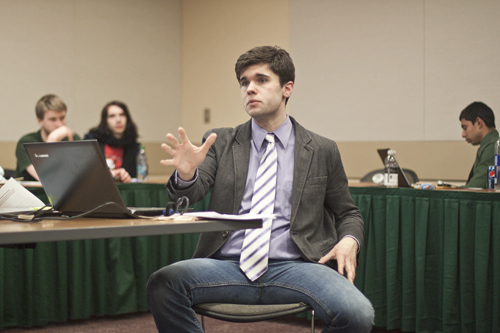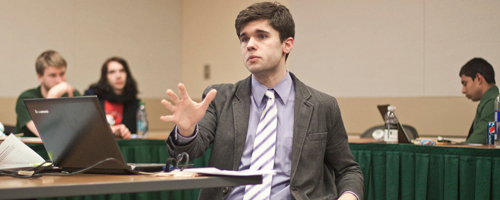Because of declining enrollment, a flat student fee and the creation of new fee-funded services and programs such as a Veterans Resource Center, the Student Fee Committee chose to decrease funding nearly across the board. Student leaders, such as publications editors and managers, will see dramatic pay cuts during the 2013-14 academic year.
SFC budget ax poised

Months of meetings and planning—and in some cases, pleading—wrapped up last week as the Associated Students of Portland State University’s student fee committee proposed just how much money it feels student groups and programs should receive next year.
Presented at a meeting of ASPSU’s executive committee on Wednesday, the final budget allocations reflected projected declining enrollment.
The projection amounted to cuts—or at least flat funding—for many groups, because more groups were asking for money from a pot of funds that is starting a downward slide.
“Usually we can allow groups to grow; this year we can’t even give them all the same,” said SFC Chair Nick Rowe.
Revenue from the $216 per 12-credit-hours students pay each quarter to support student organizations was down 1.7 percent to $13.86 million this fiscal year, which runs from July to the end of May, and a new student-fee-funded organization, the Veterans’ Resource Center, was formed.
Keeping the amount students pay to support these programs from increasing was a major goal, Rowe said.
“Basically what that means is, the cost of doing the same things went up,” Rowe said.
Organizations ranging from athletics and Campus Rec to the 5th Avenue Cinema and the Littman and White Galleries saw decreases in funding from last year’s levels, making it tough for people like Athletics Director
Michael Chisholm to offer the same level of services.
“I wish it would have worked out differently,” he said, adding that, while he understood the challenges the SFC faced because of declining enrollment, the cuts will be felt nonetheless. “We’ll have to make some difficult decisions.”
One area of particular contention is a switch in the pay model for student employees in areas such as publications, ASPSU and the cultural centers.
The change, from an hourly pay model to one called ELSA (Educational Student Leadership Awards), is meant to address the fact that many of these student employees work many more hours than they are actually paid for. Under the new model, compensation would be based on a universal tier scale, ranging from $300 to $2,100 per term depending on the position’s level of responsibility. The new model, however, will mean a pay cut for many, especially those in leadership positions.
“Our responsibilities are not decreasing, but our compensation is…vastly,” said KPSU Station Manager Jay Turk. “We already do work for below minimum wage—this brings us lower, closer to $4 an hour.”
This compensation disparity has been a known issue for at least 15 years, Rowe said, with student employees working more hours than the maximum they are allotted per term in order to complete their responsibilities.
“It’s a legal concern that students are working more hours than they are paid for, especially in publications,”
he said.
After affected student employees and student senate members voiced concerns, Rowe agreed to postpone the finalization of the proposed change to allow for more discussion. The senate has until March 13 to make recommendations on the final allocations proposed by the SFC; then the numbers will be presented to Portland State President Wim Wiewel for review.
Athletics received a cut of 1.56 percent, to $3.7 million in funding, or almost $60,000 less than last year. Campus Rec was down 0.82 percent, to $2.2 million; 5th Avenue Cinema dropped 2.1 percent, to just under $57,000; and the Littman and White Galleries’ funding was down 9.6 percent, to $42,345.
Not all groups suffered cuts, though, with some emerging as big winners. The Resource Center for Students with Children saw its budget increase 40.5 percent, to $200,000; the Queer Resource Center was up 33.6 percent, to $264,360; and the Women’s Resource Center was up 3.1 percent, to $393,510. The Veterans’ Resource Center, a new program, is starting out with an allocation of $105,016 and fills a major gap in support at PSU, Rowe said.
“It’s disappointing, given the legacy,” he said, referring to how long it took PSU to get a resource center for veterans, given the major role returning World War II veterans played in founding the school. “We have a school here due
to vets.”
“There isn’t a situation where all parties will be happy,” ASPSU President Tiffany Dollar said. “Not everyone is going to get what they want.”





